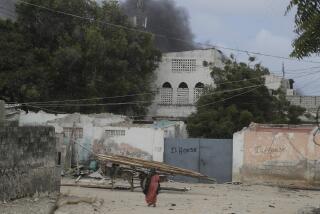U.N. Forces Attack Somali Weapon Sites : Africa: U.S. flying gunships hit clan leader Aidid’s compounds and warehouses in retaliation for the ambush-killing of 23 Pakistani peacekeepers.
- Share via
WASHINGTON — U.N. forces in Somalia, including 1,200 American soldiers and heavily armed AC-130H flying gunships, attacked strongholds of Somali clan leader Mohammed Farah Aidid early today in Mogadishu in retaliation for the ambush-killing last weekend of 23 Pakistani peacekeeping troops.
The U.N. attack, coordinated by U.S. and U.N. commanders in the area, concentrated on blowing up weapons storage compounds and warehouses belonging to Aidid and taking over a Mogadishu radio station that he has been using to promote opposition to U.N. forces, the Pentagon said in Washington, where it was still late Friday.
Earlier in the day, the United States had ordered the aircraft carrier Wasp, accompanied by three amphibious-warfare ships and carrying 2,200 Marines, to leave a training exercise near Kuwait and steam to the Straits of Hormuz to stand by if needed in Somalia.
In a clear signal that the attack was imminent, the United Nations closed Mogadishu airport to all non-U.N. traffic--until further notice--at midnight Friday and stopped U.N. relief convoys and construction projects.
U.S. officials said the main purpose of the attack was to punish Aidid, who was believed to have ordered the ambush last Saturday that killed the Pakistani soldiers, and to serve notice to other clan leaders that the United Nations will not tolerate further violence.
Clinton Administration strategists have been fearful that failure by the United Nations to retaliate for the ambush would irreparably damage the credibility of the peacekeeping operation and of similar U.N. ventures around the globe.
In line with current U.S. military doctrine, the U.N. action was swift, using overwhelming force, with the aim of destroying most of Aidid’s weapons and effectively crippling him as a political force in the country.
Pentagon officials, in constant touch with U.S. and U.N. forces in Somalia, said the attack began at 4 a.m. today in Mogadishu (6 p.m. Friday Los Angeles time), with sorties by two of the AC-130H gunships, followed by forays by ground troops. Pictures of the attack were carried live worldwide by Cable News Network.
U.N. forces have been preparing for the attack for days. U.S. troops on duty with the multinational force were brought back from outlying areas earlier this week to patrol the streets and prevent looting and vandalism.
The U.N. troops spent much of Friday digging foxholes, filling sandbags and stringing double strands of barbed wire to bolster security at the U.N. headquarters compound in case Aidid’s forces tried to attack it.
Similar preparations were under way at the airport and at Mogadishu port, which was guarded by armored personnel carriers. And the International Red Cross flew in a four-member emergency surgical team Friday with enough blood plasma to treat 1,000 casualties.
As night fell, U.N. helicopter gunships--mainly American and Italian--trained their searchlights on Mogadishu’s streets to search for possible looters and attacks by members of Aidid’s forces.
The action today came in an atmosphere of increasing violence in the Somali capital. Last Saturday, dozens of gunmen on the city’s perimeter attacked a company of Pakistani soldiers and kept reinforcements at bay. The ambush was one of the bloodiest such incidents in U.N. history. By the time it was over, 23 Pakistani soldiers had been killed and 59 others were wounded. The U.N. Security Council ordered the perpetrators apprehended.
The U.N. forces conducting today’s retaliatory attack included 1,200 members of the U.S. quick-response force made up of members of the 10th Mountain Light Infantry Battalion that has been on call in Somalia for the last two months.
The AC-130H “Spectre” gunships can deliver devastating firepower. The aircraft, a modified C-130 cargo plane, carries a 105-millimeter howitzer, a 40-millimeter and two 20-millimeter rapid-fire guns and two 7.62-millimeter mini-guns.
All are specially equipped for night operations and linked to computer fire-control devices that enable the pilot to aim merely by looking at a target and pressing a trigger-button to destroy it. They are regarded as one of the most potent weapons for such operations.
The United States flew four of the planes to neighboring Djibouti on Wednesday to help strengthen the firepower of U.N. forces in Somalia. The aircraft are based at Hurlburt Field, Fla., home of several Air Force special operations units.
Besides the quick-response force, the U.N. contingent includes about 3,000 other Americans who mainly provide logistics support and about 15,500 troops from other nations, including French, Belgian, Pakistani and Turkish soldiers.
Of the 18,500 foreign troops in Somalia, about 10,000 to 11,000 are now in Mogadishu. Four French armored personnel carriers arrived in Mogadishu from Baidoa earlier this week. And the United Nations has a dozen tanks on hand.
Although the carrier Wasp left Kuwait abruptly Friday, its 2,200 Marines and accompanying aircraft were not expected to take part in the initial assault but were to be held in reserve. Officials said that the amphibious ready group would not even reach the coast of Somalia until sometime this weekend. Besides the Wasp, it includes the landing ships Nashville and Barnstable County and the amphibious cargo ship El Paso.
The Wasp carries AV-8B Harrier jets, CH-53 Sea Stallion and CH-46 Sea Knight helicopters, AH-1W Cobra attack helicopters and UH-1N Huey helicopters. Also on board is the 450-man 24th Marine Expeditionary Force, trained for a variety of quick-reaction missions.
More to Read
Sign up for Essential California
The most important California stories and recommendations in your inbox every morning.
You may occasionally receive promotional content from the Los Angeles Times.













